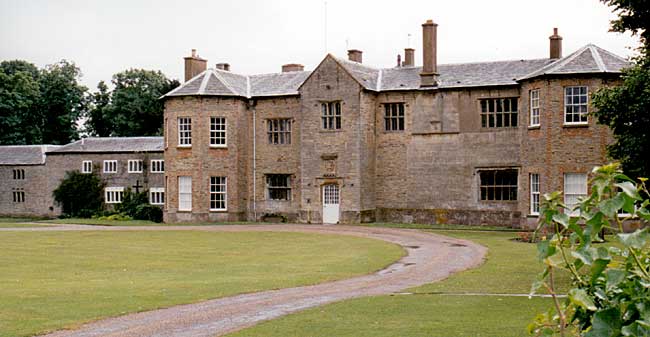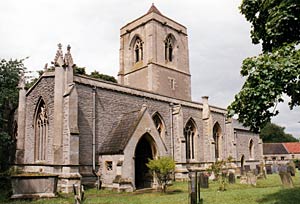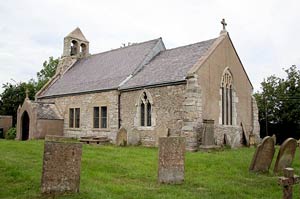< Previous | Contents | Next >
One of Sir Walter Scott's Villages
STAUNTON. Hiding in a charming corner where the county meets Leicestershire and Lincolnshire is quiet Staunton, with a fine setting in the English scene and a fine place in our literature. A flagged path embowered in trees leads to the great house and the church, in delightful company, one rich in memories of the family who have been lords of the manor from the Conquest, the other with a goodly array of their memorials.

Staunton Hall in 2001.
The long two-storeyed house, still the home of a Staunton and still partly 16th century, stands in a park with a lake at the foot of the sloping lawn where we hear the murmur of the River Devon and the little Winter Beck. Legend says that after staying here Scott made Staunton the Willingham of his Heart of Midlothian, describing it as "one of those beautiful scenes which are so often found in Merrie England."
A humble bell-rope and a beautiful golden key, with a peacock under a crown keep alive the long association of the Stauntons with Belvoir Castle seven miles away. It began when the Norman lords of Belvoir granted the manor of Staunton to an ancestor, on the tenure of Castle Guard which made him responsible for the castle's defence. The high tower at Belvoir is known as Staunton Tower, and when a sovereign visits the castle the golden key of the tower is presented by the head of the family. Now and then the Stauntons give a bell-rope to Bottesford church in memory of the days when its bells gave warning of approaching danger to the castle.
They have shared proudly in the story of our land. William was summoned to the military muster at Nottingham in 1297, Hervey was Chancellor of the Exchequer and Chief Justice in the 14th century. At the time of the Civil War William Staunton was the head of his house, and when Charles raised his standard at Nottingham he attended the king and followed him to battle. Staunton Hall was looted by the Roundheads, and their bullet holes are still in the fine old door.

Staunton church in 2001.
The beautiful church where many of them lie was made partly new last century, but the high tower, the lofty arcades, the aisle windows, and the charming north doorway are all from the close of the 14th century. The oldest relic is the fine Norman bowl of the font, enriched with interlaced arcading, its modern base set on a step which is part of a 15th century gravestone. There is an Elizabethan table, and an old almsbox made from the stump of a tree. The chief treasure of all is a beautiful oak chancel screen, with an inscription asking prayers for the soul of Simon Yates, who erected it in 1519.
The oldest of the monuments are two battered figures, one cross-legged and wearing fine chain mail, the other headless and almost legless: they may be the son and grandson of the founder of the house. An inscription to William de Staunton (of about 1250) is on a tapering stone which must have been an earlier memorial, for the arcading on its thick edge is about 1100.
The remarkable monument of a 14th century Sir William shows him as in his coffin, the lid cut away to show the upper part of his figure, and again to show his feet on a dog. Lady Joan, in a wimple and a long gown, her feet on a lion, lies on a low tomb of 1366, adorned with shields and quatrefoils. There are floorstones to her mother and her daughter. An inscription of 1757 is to Jane Degge, youngest daughter of the Harvey Staunton whose death brought to an end his family's direct succession for over 600 years without a break. Through an heiress the estates came eventually to the wife of a clergyman, who assumed the old name.
It is believed that very few families have a more complete set of documents relating to a property possessed by them from Norman times. They are preserved from 1190 and run into thousands, and among them are four original charters relating to the emancipation of Hugh Travers, the serf who carried the Cross to the Holy Land in place of Sir William de Staunton, marching with Coeur de Lion to Jerusalem. Born in bondage to de Staunton, he was set free for his crusading, shared all the perils of the expedition, suffered plague and shipwreck, and came home a hero.
STOKEHAM. Few villages can be smaller, but it has a fine view over 14 miles of England's pleasant land to Lincoln's towers.

Stokeham church in 2005.
© Copyright Richard Croft and licensed for reuse under this Creative Commons Licence
The tiny church is neat and smiling since restoration in 1928 saved it from its sorry plight, and its ancient tale is told by the Norman tub font and the rubble of much of the walling. The south side of the nave was built when the aisle was destroyed, and in it are the three arches of a tiny arcade.
There are two 13th century lancets, and the 15th century east window has the head of a man on its hood, smiling as if content that his church is so kindly restored. The pretty piscina is 14th century, there are old rafters left in the roof, an oak chest may be 700 years old, and in the churchyard is a stone coffin.
